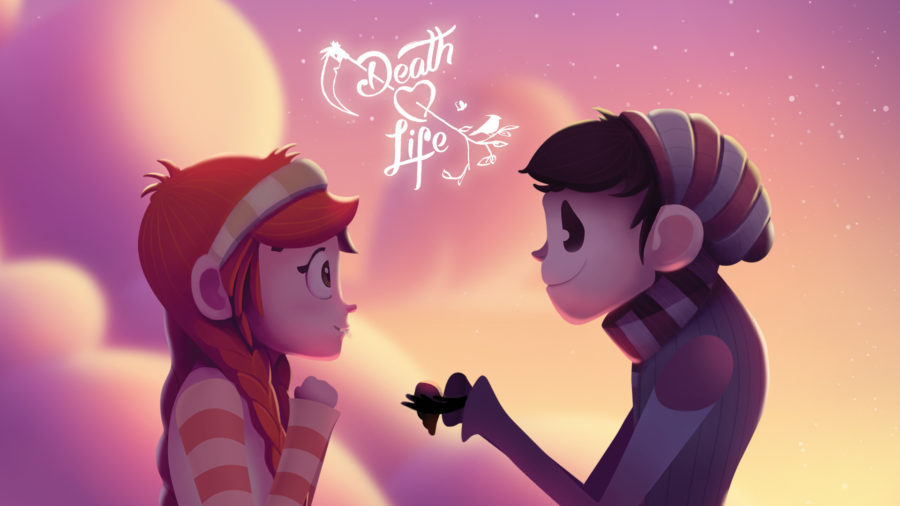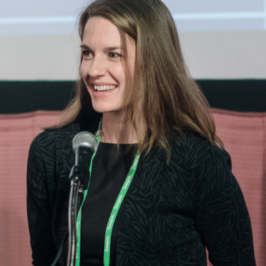In Part 1 of this blog post, Clara Lehmann details the ideation, illustration, and storyboarding of Death Loves Life, a short animated film she produced with Jonathan Lacocque. Read Part 1 here, which includes details on their work making an animated short film with illustrator Henrique Lira.

ANIMATION
Along with illustration, Lira animates as well. However, he was pitching his own animated series with Nickelodeon, Harrdy, and needed time to work on his pilot. So, we all agreed we should bring another artist on board for the animation phase. As Lira prepared the characters for animation, designed all the props in each scene, and finalized sceneries, we readied one of our favorite illustrators/animators, Ricardo Nilsson for his role.
Prior to this project and since then, we have worked with Nilsson several times on commercial projects. His ability and experience as both an illustrator and animator made the hand-off seamless. He and Lira were able to easily pass files back and forth, and Nilsson could manipulate them with ease as needed.
It also helps that both gents speak Portuguese (Lira hails from Brazil and Nilsson from Portugal). While they conversed in English for our meetings and group emails, it was exciting to see two exceptional artists on either side of the “pond” represent for the Portuguese speakers of the world!
Nilsson worked for three months, animating Death Loves Life by himself. It wasn’t until the end of animating that we brought in some additional assistance from Rachel Yonda. She helped make tweaks and finesse character movements in our final push to complete the film’s animation.
Here’s a draft of the opening sequence Nilsson sent us:
To give you an idea of how much work goes into each scene, take a look at the notes below.
Coat of Arms’ feedback on Scenes 1A to 2B
- In the beginning, let’s have the two closed flowers vibrate only once or twice before opening.
- Allow the blur to hold longer, as we see her enter frame, let’s rack focus slowly to her.
- Have the clouds moving slightly throughout
- We feel like her arms need to be re-worked. They look weird flapping right now. Maybe she’s skipping a little so her arms aren’t always flailing. They may come down or bend a bit. Something a little closer to the dancing later in the film, but not as intense. When she skips, make sure her skirt and braid bounce fluidly as well.
- Soften her facial expression and vary them a bit. Right now her eyes are huge and don’t express much. Let’s add a bit more interest, emotion, etc.
- Around 00:10 the movement of the flowers in the background is distracting — reduce the movement slightly
- Can the shadows move on the tree as well?
- Animate the pieces of hair (near her face) with a bit of bounce
- Around 00:15, when the wind blows, have her close her eyes, step forward as if pushed by the wind, and maybe scrunch her eyebrows to protect her eyes as the wind blows.
- Around 00:17 have slightly less movement in the field of flowers again. It’s just a little too much.
- Make Death’s legs kick back and forth/swing.
- Add a small lens flare or reflection on the end of Death’s scope, so we are drawn to it.
And here’s the final opening so that you can see the amount of work Nilsson put into the animation:
SCORING
Despite the fact that The License Lab kindly donated a library of tracks to us, we felt an original score would be best for the film. That’s when we approached German composer and musician, Marius Kirsten. Kirsten had worked with Henrique Lira on his film Harrdy and came with glowing references. Over a Skype conversation and several emails, we defined the style:
“Overall, the piece should feel light and happy, but the mood of the music should follow the seasons: Spring, Summer, Fall, Winter. And the time of day: Morning, Afternoon, Evening, Night. The characters, Life and Death, are introduced in Spring/Summer, when the flower scene takes place.
Life dances through summer. Death gains some confidence to approach Life but kills her bird accidentally in the Fall. And finally, the two come together in the barren field in Fall/Winter, when Life dies. Hints of Life continue to populate scenes (even at the end) to give us hope. The audience should be left feeling fulfilled and at ease.
Death, overall, is a bit more awkward, shy, and doesn’t understand himself. Life is a free spirit, joyful and wears her emotions on her sleeve. Together, these two harmonize perfectly.”
We continued to break down the script by important moments and express the mood for each beat so that Kirsten could get started on scoring. Over three weeks, Kirsten drafted a score and completed two rounds of revisions.
Some of the more complex and time-consuming notes included removing and playing down the defining instrument (the flute) chosen for Life’s scenes, adjusting a few of the transitions between scenes, and reworking and finessing the music where Life dies. Kirsten worked hard to balance the light and melancholy tones of the film. And as you can imagine, he likely spent a lot of hours here:
Marius Kirsten’s Composing Bay
SOUND DESIGN
The last step, but a very important one for finishing any film, was sound design and mix. Shawn Wilson performed the sound design and BAM Studios’ Matt Sauro did the 5.1 surround sound mix. When we initially reached out to Wilson, we explained,
“The sound will have to really sell this. The environment of each scene, from the birds to the wind, is really important. We want the sounds to be rich and to bring the viewer into this world. Feel free to have fun being creative on this first pass. This is a cartoon, so the sounds don’t all have to be from the ‘real world’ – they can be slightly different, have effects or have different tones than we might expect. We don’t want to make it weird, but we want this to be bright and vibrant like the artwork.”
Initially, we also paired specific sounds for each character. Nature or natural sounds were paired with Life, and wilting and bone-rattling sounds were for Death. A lot of the more subtle instances of this made it into the film, but we ended up scrapping a good deal of this language as it was too heavy-handed. The music also helped define the characters as the flute is primarily used for scenes with Life and the bassoon is used for Death.
When Sauro and BAM Studios got involved, they did some cleanup, leveling, and equalization. Sauro added a few sound effects to the scene where Life dies since that scene, in particular, is the climax of the story and artistically interesting. The collaboration, between BAM/Sauro and Wilson proved very worthwhile.
Our filmmaker friends, Elane McMillion Sheldon and Kerrin Sheldon performed the voices for Life and Death. These two clearly had fun recording. While scrubbing through the voiceover, we noticed that Elaine kept humming the ‘Star Spangled Banner.’ She must have been feeling very patriotic that day. In fact, one of their cute outtakes made it into the cut. At the end of the credits, Elaine starts humming. She laughs. Kerrin cracks up and says, “That’s a wrap.”
Death Loves Life screened at the Academy accredited, Los Angeles Shorts Film Festival and the Cleveland International Film Festival, the West Virginia International Film Festival, and the Gdansk International Animation Film Festival in Poland, among others.
Watch the full film here and support our art by purchasing a Death Love Life poster from our little shop. We would like to sincerely thank all the fine artists involved in the film. We’re looking forward to the next one.

